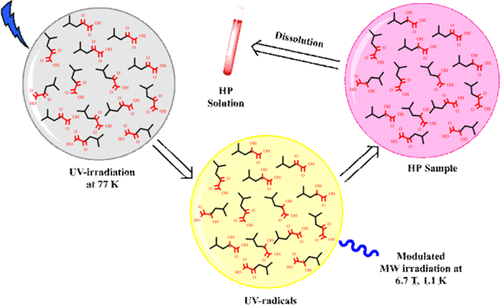当前位置:
X-MOL 学术
›
J. Phys. Chem. C
›
论文详情
Our official English website, www.x-mol.net, welcomes your
feedback! (Note: you will need to create a separate account there.)
UV-Irradiated 2-Keto-(1-13C)Isocaproic Acid for High-Performance 13C Hyperpolarized MR
The Journal of Physical Chemistry C ( IF 3.3 ) Pub Date : 2020-10-19 , DOI: 10.1021/acs.jpcc.0c07536 Saket Patel 1 , Arthur C. Pinon 1 , Mathilde H. Lerche 1 , Magnus Karlsson 1 , Andrea Capozzi 2 , Jan Henrik Ardenkjær-Larsen 1
The Journal of Physical Chemistry C ( IF 3.3 ) Pub Date : 2020-10-19 , DOI: 10.1021/acs.jpcc.0c07536 Saket Patel 1 , Arthur C. Pinon 1 , Mathilde H. Lerche 1 , Magnus Karlsson 1 , Andrea Capozzi 2 , Jan Henrik Ardenkjær-Larsen 1
Affiliation

|
Enhancing the sensitivity of magnetic resonance spectroscopy/imaging (MRS/MRI) by dissolution dynamic nuclear polarization (dDNP) has expanded the scope of MRS applications to new fields of research. Most importantly, it has paved the way toward noninvasive studies of the fate of a metabolite in real time. As its name implies, in a typical dDNP experiment, the hyperpolarized (HP) sample is extracted from the polarizer in the liquid state. This procedure limits the HP signal exploitation time window to approximately 1 min, but it is also the only way to preserve the high spin order created in the solid state at low temperatures of 1–1.5 K and moderate magnetic fields of 3.35–7 T by means of microwave irradiation. Indeed, although necessary for the DNP process to happen, the presence of free radicals in the sample would prevent its extraction as a solid for relatively longer-term storage and transport to remote locations. Moreover, for biological or clinical applications, the radical should be removed from the hyperpolarized (HP) solution. This limitation can be overcome using thermally labile ultraviolet (UV)-generated radicals that have been shown to be efficient polarizing agents, to provide a radical-free HP solution, and most importantly, to pave the way for the transport of HP solid samples to remote sites. Herein, we demonstrate that 2-keto[1-13C]isocaproate (KIC), an important metabolic biomarker in the brain, can be highly polarized via dDNP using the nonpersistent ketyl radical generated by UV irradiation of the substrate itself. We investigated the precursor molecule and radical properties via UV–vis measurements and ESR measurements at both X-band and high field. After optimizing sample preparation and microwave irradiation conditions, we obtained 56% 13C liquid-state polarization in 1 h by performing dDNP at 6.7 T and 1.1 ± 0.1 K.
中文翻译:

UV照射2-酮(1- 13 C)异己酸用于高性能13 Ç超极化的MR
通过溶解动态核极化(dDNP)增强磁共振波谱/成像(MRS / MRI)的灵敏度,将MRS的应用范围扩展到了新的研究领域。最重要的是,它为实时代谢物命运的非侵入性研究铺平了道路。顾名思义,在典型的dDNP实验中,超极化(HP)样品是从液态偏振器中提取的。此过程将HP信号利用时间窗口限制为大约1分钟,但这也是保持固态在1–1.5 K低温和3.35–7 T中等磁场下产生的高自旋阶的唯一方法。微波辐射的手段。确实,尽管DNP流程需要进行,样品中自由基的存在会阻止其提取成固体,以便相对长期地存储和运输到偏远地区。此外,对于生物学或临床应用,应从超极化(HP)溶液中除去自由基。可使用热不稳定的紫外线(UV)产生的自由基克服上述局限,这些自由基已被证明是有效的偏振剂,可提供无自由基的HP溶液,最重要的是,可将HP固体样品运输至远程站点。在这里,我们证明2-酮[1- 可使用热不稳定的紫外线(UV)产生的自由基克服上述局限,这些自由基已被证明是有效的偏振剂,可提供无自由基的HP溶液,最重要的是,可将HP固体样品运输至远程站点。在这里,我们证明2-酮[1- 可使用热不稳定的紫外线(UV)产生的自由基克服上述局限,这些自由基已被证明是有效的偏振剂,可提供无自由基的HP溶液,最重要的是,可将HP固体样品运输至远程站点。在这里,我们证明2-酮[1-13 C]异己酸(KIC)是大脑中一种重要的代谢生物标志物,可以使用底物本身通过紫外线照射产生的非持久性酮基,通过dDNP高度极化。我们通过X波段和高场的UV-vis测量和ESR测量研究了前体分子和自由基的性质。优化样品制备和微波辐射条件后,通过在6.7 T和1.1±0.1 K下进行dDNP ,我们在1小时内获得了56%的13 C液态极化。
更新日期:2020-10-30
中文翻译:

UV照射2-酮(1- 13 C)异己酸用于高性能13 Ç超极化的MR
通过溶解动态核极化(dDNP)增强磁共振波谱/成像(MRS / MRI)的灵敏度,将MRS的应用范围扩展到了新的研究领域。最重要的是,它为实时代谢物命运的非侵入性研究铺平了道路。顾名思义,在典型的dDNP实验中,超极化(HP)样品是从液态偏振器中提取的。此过程将HP信号利用时间窗口限制为大约1分钟,但这也是保持固态在1–1.5 K低温和3.35–7 T中等磁场下产生的高自旋阶的唯一方法。微波辐射的手段。确实,尽管DNP流程需要进行,样品中自由基的存在会阻止其提取成固体,以便相对长期地存储和运输到偏远地区。此外,对于生物学或临床应用,应从超极化(HP)溶液中除去自由基。可使用热不稳定的紫外线(UV)产生的自由基克服上述局限,这些自由基已被证明是有效的偏振剂,可提供无自由基的HP溶液,最重要的是,可将HP固体样品运输至远程站点。在这里,我们证明2-酮[1- 可使用热不稳定的紫外线(UV)产生的自由基克服上述局限,这些自由基已被证明是有效的偏振剂,可提供无自由基的HP溶液,最重要的是,可将HP固体样品运输至远程站点。在这里,我们证明2-酮[1- 可使用热不稳定的紫外线(UV)产生的自由基克服上述局限,这些自由基已被证明是有效的偏振剂,可提供无自由基的HP溶液,最重要的是,可将HP固体样品运输至远程站点。在这里,我们证明2-酮[1-13 C]异己酸(KIC)是大脑中一种重要的代谢生物标志物,可以使用底物本身通过紫外线照射产生的非持久性酮基,通过dDNP高度极化。我们通过X波段和高场的UV-vis测量和ESR测量研究了前体分子和自由基的性质。优化样品制备和微波辐射条件后,通过在6.7 T和1.1±0.1 K下进行dDNP ,我们在1小时内获得了56%的13 C液态极化。











































 京公网安备 11010802027423号
京公网安备 11010802027423号